Asian Elephant Profile
The Asian elephant is a huge herbivorous mammal found in India and South East Asia.
Along with the African bush elephant and the African forest elephant, they are one of the largest living land mammals on earth and their size, long trunk and huge ears make them unmistakable.
They differ to the two African elephant species in that they are slightly smaller, have smaller ears and patches of pink on their forehead and ears.
Asian elephants also have a single extended ‘tip’ on the end of their trunk, whereas African elephants have two, one on the upper and one on the lower lip of their trunk. This feature helps elephants grasp their food.
Asian elephants are found in pockets of forest across 13 countries, including India, China, Vietnam and Malaysia. Their range has been vastly reduced due to habitat loss as these huge animals require large areas to survive.
Poaching has also played a disastrous role in reducing their numbers across their range. More than half of the world population of Asian Elephants are found in India with far fewer individuals remaining in the other 12 countries.
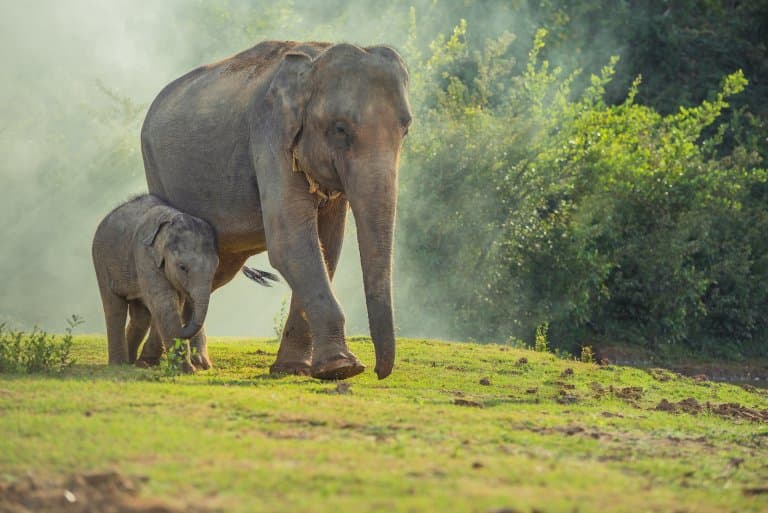
Asian Elephant Facts Overview
| Habitat: | Various forest habitats, as well as grasslands |
| Location: | India and South East Asia |
| Lifespan: | 65 years in the wild |
| Size: | Height up to 3m, and length up to 6.5m |
| Weight: | Males can weigh up to 6,000 kg |
| Color: | Gray color skin covered sparsely with hair |
| Diet: | Herbivore, feeding entirely on a huge variety of plant material |
| Predators: | Calves may be predated on by tigers, but no natural predators |
| Top Speed: | 25 kph (16 mph) |
| No. of Species: |
1 |
| Conservation Status: |
Endangered |
Asian elephants are often associated with forest habitat but prefer areas where forest as well as grassland occur, therefore having a greater variety of plant species to feed on. Like all elephant species, they pend much of the day feeding as their large body mass requires equally large amounts of plant material to sustain themselves.
Asian elephants are also highly dependent on water and will travel extremely long distances to find suitable sources. As well as feeding on different plant leaves, they will also feed on fruit and tree bark and are known to visit salt licks to ensure that their diet is rich in minerals also.
They use their trunks to grasp and pull food into their mouths as well as sucking up water and squirting it into their mouths to drink. Only males possess tusks and these are used occasionally to fight, but more commonly to strip tree bark as well as digging up tubers from the ground.
Asian elephants are highly sociable animals and live in herds of up to 20 individuals and sometimes more in suitable habitats. They live in matriarchal herds, led by a single, and often oldest, female and consisting of her relatives and offspring. Adult male Asian elephants usually live in smaller herds or by themselves and are only found with female herds when attempting to mate with females.
The social structure within Asian elephant herds is extremely complex due to the high level of intelligence that these animals exhibit. Researchers have found that there is a dominance hierarchy that ensures the herd has the best chance of survival and that disputes are settled with little confrontation.
As well as being highly intelligent, studies have shown that all elephants possess a deep reservoir of emotional depth and tend to look after other members in the herd.
Although most often seen during the day, Asian elephants are also active at night. Due to their large size, they must spend much time searching for food so generally only rest during the hottest parts of the day and after feeding.
Despite their massive frames, they are able to move through the forest almost silently and are usually only heard when eating or breaking tree branches.
Asian elephants use their prehensile trunks in a variety of ways and this allows them to access foods out of reach to other terrestrial mammals. The finger-like projection at the trunk tip is used to grasp twigs and leaves and pull them into the elephants’ mouth.
The trunk itself is use to draw up water, filter out dirt and debris and squirt the relatively clean water into their mouths. They also use their trunks to smell their surroundings, breathe when swimming and as a means of greeting one another.
The ICUN classifies the Asian elephant as endangered, due to the continued degradation and fragmentation of its habitat, as well as poaching for ivory, meat and leather.
In some parts of Asia, these elephants have coexisted with humans for thousands of years relatively peacefully, while in other regions there is continued conflict.
Interesting Asian Elephant Facts
1. They are one of the largest land living animals in the world
Asian and African elephants are bigger than any other animal found on land. Only some of the ocean-dwelling whale species are bigger.
The Asian elephant is 2nd in our largest land animals in the world list after the African bush elephant. 1
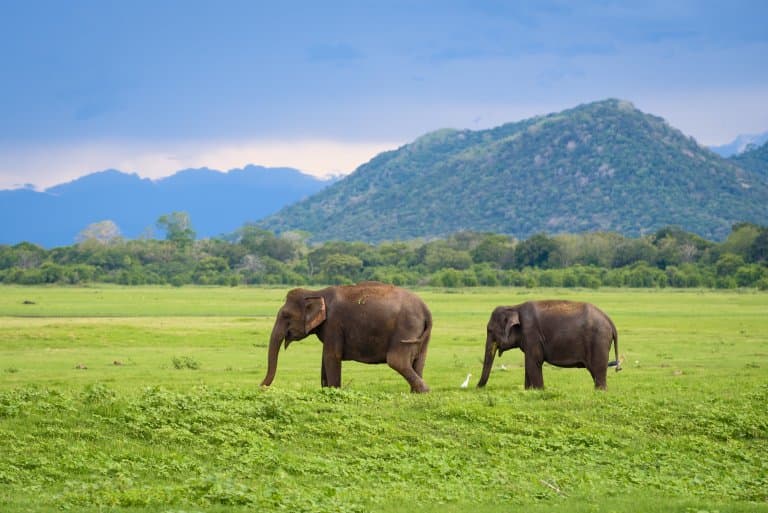
2. In Asian elephants, it is only the males that possess tusks
Unlike the African elephants, where both sexes have tusks, only male Asian elephants carry tusks.
3. Their tusks are actually overgrown teeth
Made of ivory and dentine, elephant tusks are actually teeth which protrude out from the mouth.
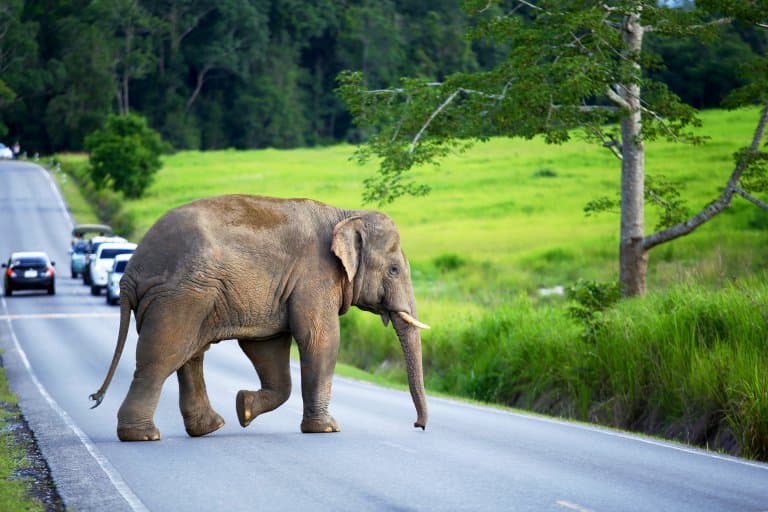
4. Elephants touch trunks to greet one another
When meeting other elephants, both individuals will touch trunks, much like a human handshake.
5. Adult Asian elephants need to eat around 150kg of food per day
To make sure they have enough energy to carry their huge body mass, elephants need to eat for most of the day.
6. They are also very fond of mud
By squirting mud over their bodies and rolling in mud pits, Asian elephants create their own sunscreen and insect repellent. 2
7. Asian elephants thoroughly enjoy water and are excellent swimmers
Holding their trunks above the water, elephants are able to swim long distances and seem to relish in playing in water.
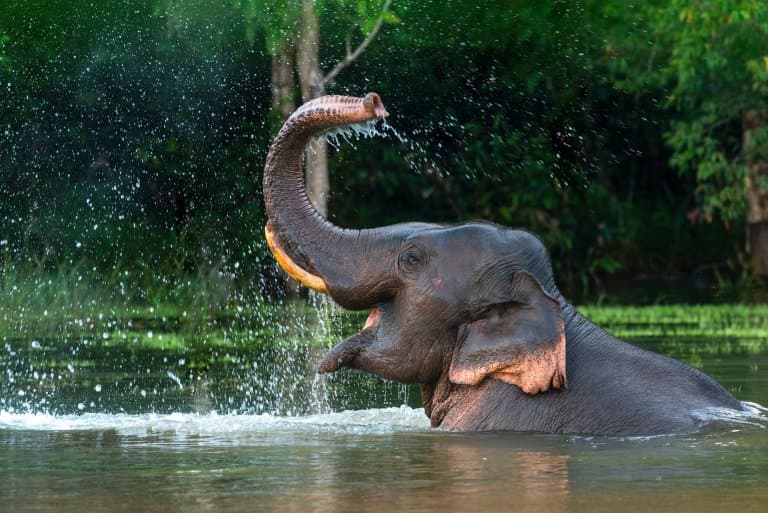
8. Asian elephants have poor eyesight
Asian elephants have a somewhat poor sense of sight and rely on their other senses for day to day life.
They have an exceptional sense of smell and good hearing and are able to detect a multitude of chemical signals within their habitat.
9. Tusk size is determined by genetics
If an elephant’s father had large or small tusks, it is likely that that offspring will inherit those genes and have similar sized tusks. 3
10. Breeding in Asian elephants occurs on average only every 4 years
This is because elephant mothers provide milk for their calves for up to 3 years after birth, although the calf may already be eating solid foods.
Female Asian elephants are exceptional mothers and very rarely leave the calf for any length of time. Other mature females also take turns caring for the young calves as they develop their life skills.
Male Asian elephants do not usually take any part in caring for the young as after mating with one female, they will continue to try to mate with other females.

11. Only the strongest males are selected to breed
Females will also only mate with the strongest male elephant, who is often in musth; a condition where a males’ reproductive hormones have risen considerably and he becomes aggressive to other males as well as other animals in his vicinity.
In order for males to enter this stage, they have to be extremely healthy and have reached sexual maturity. This breeding system ensures that only the strongest males mate with females and thus the offspring will inherit these impressive genes.
12. They are vocal
They have different vocalisations for different scenarios and can communicate with other herds or individuals through chemicals in their dung and urine. Elephants also have very sensitive trunks, especially the tip, and this allows them to feel for food, avoiding unsuitable vegetation as well as reinforcing bonds with one another.
Through their calls they are able to communicate over vast distances and are able to vocalise in infrasound, which humans cannot hear.
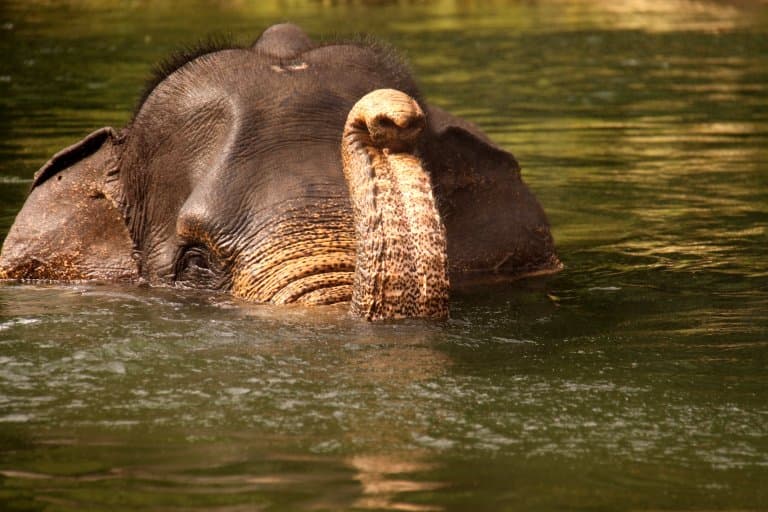
13 Asian elephants are extremely intelligent and relatively easy to train
In some countries, Asian elephants are still used to help in forestry and agriculture, where their power makes light work of carrying and pulling heavy loads. 4
14. They are docile and gentle giants but are very protective and easily disturbed
Although elephants try to avoid humans at all costs, they are sometimes forced to charge and attack people when cornered or when they feel threatened.
The rest of the time, they quietly avoid human settlements.
15. Elephants show signs of grief much like humans do
When a member of the herd dies, other elephants will sometimes stay with the dead elephant for days on end, similar to mourning in humans.

16. Asian elephants have long memories
Asian elephants are able to remember trails to water and food sources, even after decades of not visiting that area. They also pass this knowledge on to other members who in turn imprint these routes into their memory. 5
17. They are key to the ecosystem
Asian Elephants are crucial to the ecosystems in which they inhabit and their absence often changes entire landscapes. Not only are they vital in dispersing seeds of many thousands of plant species but they also maintain the balance of that ecosystem.
Their trampling and selectivity when feeding creates a diverse environment, meaning no one species of vegetation becomes over dominant in that area. This in turn creates separate micro habitats for a greater variety of smaller animals, many of which rely on the activities of elephants to survive in that area.
Despite their significant importance to the ecosystem and their revered status, both Asian and African elephant populations are in danger due to poaching for their ivory and the destruction of their habitat.
Asian Elephant Fact-File Summary
Scientific Classification
| Kingdom: | Animalia |
| Phylum: | Chordata |
| Class: | Mammalia |
| Order: | Proboscidea |
| Family: | Elephantidae |
| Genus: | Elephas |
| Species Name: |
Elephas Maximus |
Fact Sources & References
- Emma Hankinson (2020), “Asian Elephants: 15 years of research and conservation”, Research Gate.
- “Asian Elephant Facts”, International Elephant Project.
- “Asian Elephant”, World Wild Life.
- Steven A. Frank & Martin A. Nowak (2003), “Are fast-moving elephants really running”, Nature Publishing Group.
- “Asian Elephants”, WWF.
